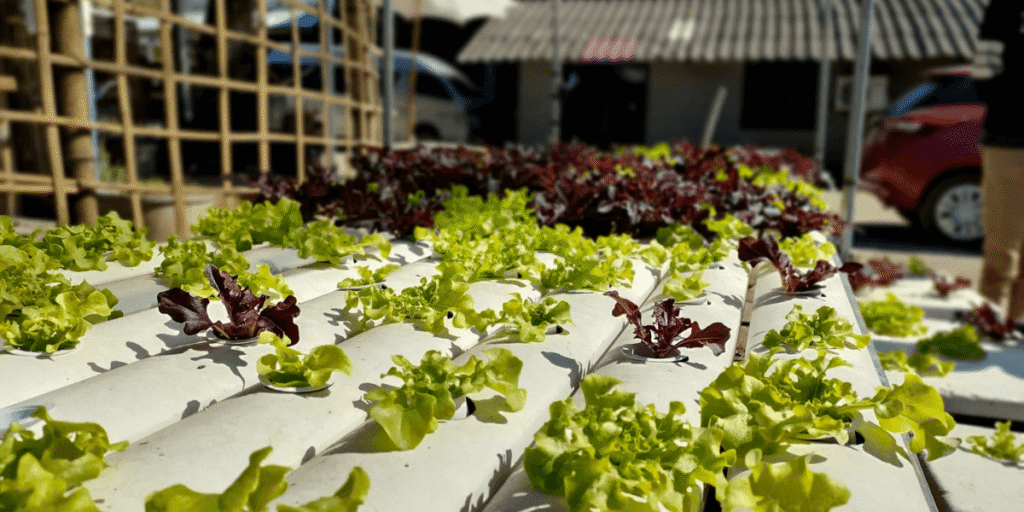Grow Leafy Greens in Hydroponics and enjoy fresh, crisp lettuce or fragrant basil straight from your kitchen, no matter the season. With hydroponic systems, cultivating leafy greens becomes not only possible but surprisingly simple. These fast-growing, nutrient-dense plants thrive in soilless setups, making them the perfect choice for beginners and seasoned growers alike.
Hydroponics provides a clean, efficient, and highly rewarding way to produce your own vegetables at home. Say goodbye to messy soil, garden pests, and unreliable weather conditions. Instead, take full control of your greens’ growth, from light and nutrients to harvest timing. Ready to bring your indoor garden to life? Let’s dive into how you can grow a continuous supply of leafy vegetables using this innovative method.
Why Choose Indoor Hydroponics for Leafy Greens? Benefits of Soilless Gardening
Choosing to cultivate your leafy greens hydroponically indoors comes with a heap of benefits that traditional gardening just can’t match:
- Year-Round Harvests: No more waiting for spring! You can enjoy fresh greens 365 days a year, regardless of your local climate.
- Cleaner & Safer Produce: Without soil, you dramatically reduce the risk of soil-borne pests and diseases. This means less (or zero!) need for pesticides, leading to healthier, cleaner food for your family.
- Healthier Eating, Made Easy: Having fresh greens at your fingertips makes it simple to incorporate more nutrient-rich vegetables into your diet.
- Space-Saving Solutions: Hydroponic systems, especially vertical setups, let you grow a surprising amount of food in a very small footprint, perfect for apartments, kitchens, or small grow spaces.
- Faster Growth: With their roots immersed in nutrient-rich water and exposed to optimal lighting, leafy vegetables tend to grow significantly faster using soilless cultivation compared to traditional soil methods.
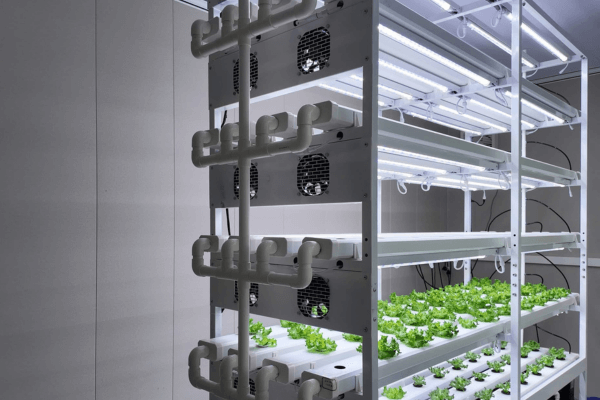
Best Hydroponic Systems for Efficient Leafy Green Production
While many hydroponic systems exist, some are particularly well-suited for growing leafy greens indoors, especially for beginners.
1. Deep Water Culture (DWC): Ideal Setup for Growing Leafy Vegetables
How it Works: In a DWC system, your plants sit in net pots with their roots submerged directly into a reservoir of nutrient-rich water. An air pump and air stone keep the water oxygenated, preventing root rot.
- Why it’s Great for Greens: DWC is incredibly simple to set up and maintain. It’s inexpensive, has few moving parts, and is very forgiving, making it perfect for fast-growing leafy greens like lettuce and spinach. You can easily build a small system with a dark plastic container, an air pump, an air stone, and some net pots.
- Ideal for: Lettuce, spinach, kale, Swiss chard, basil, mint.
2. Nutrient Film Technique (NFT): Scalable Hydroponic Solution for Greens
How it Works: Plants are placed in channels, and a thin film of nutrient solution flows continuously over their roots. The slight slope of the channels allows gravity to return the solution to a reservoir, creating a continuous loop.
- Why it’s Great for Greens: NFT is highly efficient with water and nutrients. The constant flow ensures roots get both water and oxygen, leading to rapid growth. It’s often used in commercial settings due to its efficiency but can be scaled down for home use.
- Ideal for: Lettuce, spinach, herbs (like basil, cilantro), and other fast-growing, non-fruiting greens.
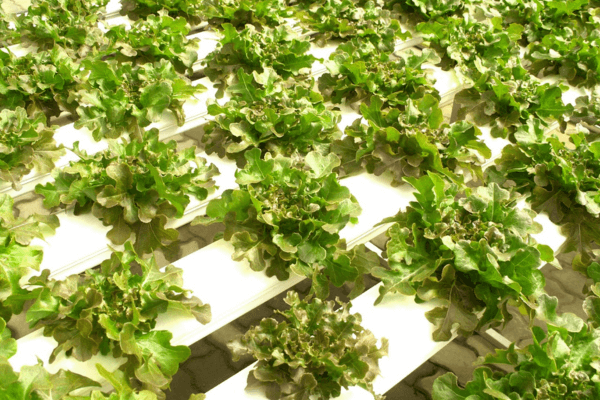
3. Wick System: Simple, Low-Maintenance Hydroponics for Leafy Crops
How it Works: This passive system uses a wick (like a rope or felt strip) to draw nutrient solution from a reservoir up into the growing medium around the plant’s roots, much like a candle wick draws wax.
- Why it’s Great for Greens: No pumps, no electricity (unless for lights), and minimal maintenance. It’s incredibly simple to set up with everyday items.
- Ideal for: Smaller leafy greens and herbs, especially during the seedling phase or for a very compact setup.
Top Leafy Greens Suitable for Hydroponic Cultivation
Almost any leafy green will thrive in a hydroponic system, but some are particularly fast-growing and rewarding:
- Lettuce (especially loose-leaf varieties like Romaine, Butterhead, or Salanova): Grows incredibly fast, often ready for harvest in just 3-4 weeks.
- Spinach: Another quick grower, providing tender, nutritious leaves.
- Kale (various types): Hardy and productive, offering continuous harvests.
- Basil: A fragrant herb that absolutely loves hydroponics, producing abundant leaves.
- Mint: Spreads easily and provides a continuous supply of refreshing leaves.
- Swiss Chard: Beautiful, colorful, and a continuous producer of healthy greens.
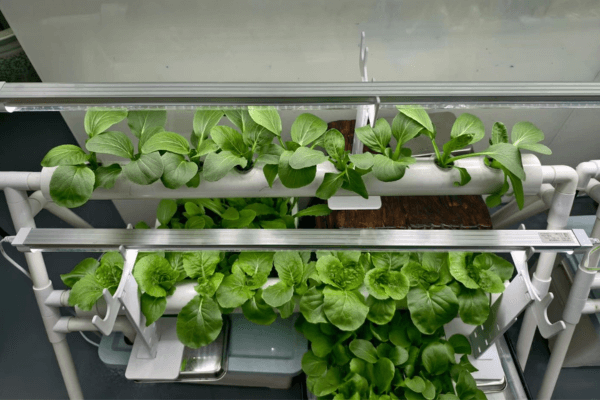
Step-by-Step Guide to Growing Leafy Greens with Hydroponics
Ready to get your hands wet? Here’s how to ensure your leafy greens thrive in hydroponics:
Step 1: Seed Sprouting for Healthy Leafy Plants
- Medium: Use specialized rockwool cubes, coco coir pellets, or peat plugs.
- Process: Place 2-3 seeds in each cube/pellet. Keep them consistently moist and warm (around 20-25°C) in a propagation tray with a clear dome to maintain humidity. They’ll usually sprout in a few days to a week.
Step 2: Preparing Nutrient Solutions for Optimal Growth
- Water Quality: Use clean, filtered water. Tap water is often fine if not too hard, but filtered water is ideal.
- Nutrients: Purchase a hydroponic nutrient solution specifically formulated for leafy greens (often “Grow” formulas). Always follow the manufacturer’s mixing instructions precisely! Over-fertilizing can harm plants.
- pH Balance is Key: This is crucial for nutrient uptake. Leafy greens prefer a slightly acidic pH, typically between 5.5 and 6.5. Use a pH testing kit (liquid drops or a digital meter) and adjust with “pH Up” or “pH Down” solutions as needed. Check daily for the first few days, then every 2-3 days.
- Nutrient Strength (EC/TDS): For most leafy greens, aim for an EC (Electrical Conductivity) between 1.2-1.8 mS/cm or TDS (Total Dissolved Solids) between 600-900 PPM. An EC/TDS meter is highly recommended for accuracy.
Step 3: Transplanting Seedlings into Hydroponic Systems
Once your seedlings have developed their first set of “true leaves” (the second set, looking like miniature versions of the adult leaves) and you see roots peeking from the bottom of their starter cubes, they’re ready! Gently place each seedling (still in its cube) into the net pots of your chosen hydroponic system, ensuring the roots are submerged in the nutrient solution.
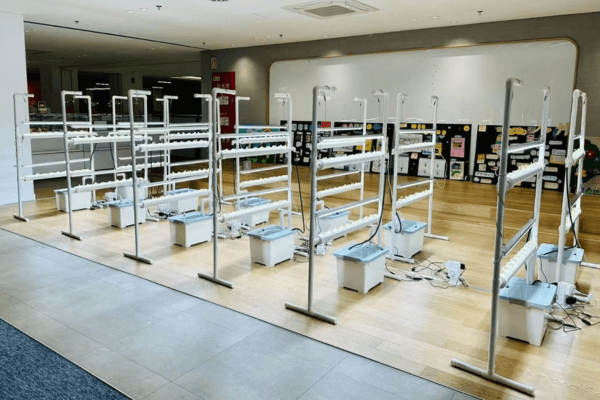
Step 4: Creating the Right Environment for Year-Round Leafy Growth
This is where you truly become the master of your greens’ destiny, ensuring robust growth even in winter.
- Light (Your Indoor Sun):
- Type: LED grow lights are your best bet for energy efficiency and customizable spectrum.
- Duration: Leafy greens typically need 14-18 hours of light per day, followed by 6-10 hours of darkness. Use a timer for consistency.
- Intensity (PPFD/DLI): Aim for a PPFD of 150-300 μmol/m²/s directly above the plants. The DLI should be around 8-12 mol/m²/day. Keep your lights 12-18 inches (30-45 cm) above the plant canopy, adjusting as they grow.
- Temperature: Maintain an ambient temperature of 18-24°C (65-75°F) for most leafy greens.
- Humidity: A relative humidity of 50-70% is ideal. Use a hygrometer to monitor.
- Air Circulation: A small oscillating fan helps strengthen stems, improve CO2 distribution, and prevent stagnant air, which can lead to fungal issues.
Step 5: Routine Care and Monitoring of Hydroponic Vegetables
Consistent care is key to continuous harvests.
- Check Water Level Daily: Top up with plain, pH-balanced water (not nutrient solution, as only water evaporates).
- Monitor pH & EC/TDS: Check every 2-3 days and adjust as needed. The pH tends to drift, so regular checks are vital.
- Change Nutrient Solution: Completely drain and refill your reservoir with fresh nutrient solution every 1-2 weeks. This prevents nutrient imbalances and algae buildup. Give the reservoir a quick clean during refills.
- Watch Your Plants: Observe your plants daily for any signs of nutrient deficiency (yellowing leaves), pest issues, or light stress. Precision in these steps is crucial for ensuring healthy, high-yielding plants, whether you’re growing leafy greens or looking into more complex crops like hydroponic tomatoes.
Step 6: Harvesting Fresh Greens from Your Hydroponic Setup
Leafy greens are often ready for harvest quickly!
- Continuous Harvesting: For most greens, you can perform a “cut-and-come-again” harvest. Simply snip the outer leaves, leaving the inner leaves to continue growing. This allows for multiple harvests from a single plant.
- Full Harvest: You can also harvest the entire plant by cutting it at the base. Mastering these techniques helps maximize crop yields with grow lights, ensuring you get the most from your hydroponic system.
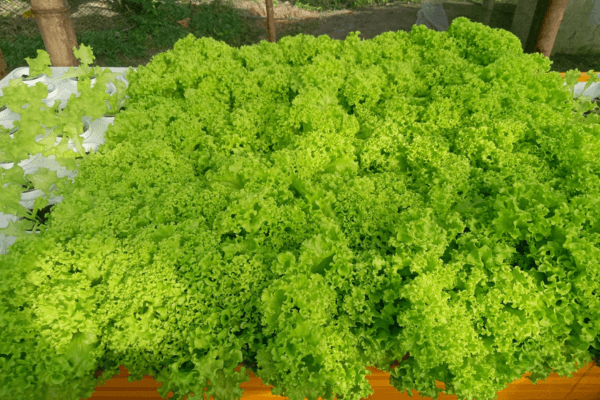
Common Issues When Growing Leafy Greens Hydroponically and Quick Fixes
Even experienced growers face hiccups. Here’s how to troubleshoot common issues with leafy greens:
- Yellowing Leaves: This often indicates nutrient deficiency, especially nitrogen, incorrect pH levels that lock out nutrients, or insufficient light. Check and adjust pH, EC, and light intensity accordingly.
- Stretching (Leggy Plants): Usually caused by low light intensity. Try lowering your grow light or increasing its brightness.
- Algae Growth in Reservoir: Occurs when light reaches the nutrient solution. Make sure your reservoir is fully opaque and light-proof, and clean it thoroughly during nutrient changes.
- Root Rot (Slimy/Brown Roots): Caused by low oxygen levels in the water or high temperatures. Ensure your air pump and air stone are functioning well to provide adequate aeration. If the environment is warm, consider cooling methods like insulating the reservoir or adding frozen water bottles. Immediately replace the water, trim damaged roots, and clean your system thoroughly.
- Tips Browning/Crisping: Could be due to nutrient burn from excessively high EC or light burn from lights being too close or intense. Check EC levels and raise your lights as needed.For plants with specific needs, like strawberries,check out our guide on how to grow hydroponic strawberries.
Frequently Asked Questions About Hydroponic Leafy Green Cultivation
Flavor Troubles
Q1: My greens taste kind of bland. Am I messing something up?
A1: Not necessarily. Some greens just have a milder taste by nature. But if you’re looking for more flavor, light can make a big difference. Make sure your plants are getting enough intensity and a full spectrum, especially red, a bit of far-red, or even UV. Also, check your nutrient balance (EC/TDS). A little adjustment can really boost that flavor punch.
Energy & Efficiency
Q2: Running grow lights 16 hours a day sounds expensive. Is it?
A2: Totally fair question. The good news is that modern LED grow lights are super energy-efficient. For most home setups, the electricity cost is pretty low, especially compared to buying store greens all the time. If you want to save even more, look for lights with dimmers or use staggered light cycles.
Water & Nutrient Maintenance
Q3: Do I really need to change the water and nutrients so often?
A3: Ideally, yes, every 1 to 2 weeks. It might sound like a lot, but clean, fresh nutrient solution keeps your plants growing strong and prevents things like algae or salt buildup. Once you get into the habit, it’s quick and totally worth it for healthy, tasty harvests.
Root Health
Q4: My plant roots look brown and kind of slimy. What’s going on?
A4: Sounds like root rot, which is pretty common but fixable. It usually happens when water isn’t getting enough oxygen or it’s too warm. First, check your air pump and air stone. Still bubbling? Good. If your room’s warm, try cooling the water with frozen bottles. Then clean your system, trim the bad roots, and start fresh with new solution.
Nutrient Recycling
Q5: Can I reuse the old nutrient solution I drained out?
A5: It’s tempting, but not the best idea, especially for beginners. Plants absorb nutrients unevenly, so what’s left behind can be unbalanced. If you really don’t want to waste it, dilute it and use it on outdoor plants. But for hydroponics, using a fresh mix helps avoid problems and gives better results.
Build Your Year-Round Indoor Garden with Hydroponic Leafy Greens
Growing leafy greens hydroponically indoors is a journey that’s both rewarding and incredibly practical. From the simple bubbling of a DWC system to the precise flow of an NFT setup, you’re gaining control over your food source, enjoying fresher, healthier produce, and connecting with the fascinating science of plant growth.
It’s an accessible way to ensure you always have a vibrant supply of your favorite greens, right at your fingertips, regardless of what Mother Nature has in store. So why wait for the next growing season? Your indoor hydroponic garden is ready to sprout!
Ready to Harvest Fresh, Home-Grown Hydroponic Greens?
Whether you’re starting with a small indoor setup or planning a full-scale hydroponic garden, growing leafy greens in hydroponics is easier and more rewarding than ever. This soilless method uses less water, saves space, and lets you harvest fresh, nutrient-packed greens all year round right from your own home.
No matter if you’re a gardening pro or just curious about sustainable growing, our step-by-step guide will help you master the essentials of hydroponic leafy greens. From choosing the right system to maintaining ideal conditions, we’ve got practical tips and expert advice to support you at every stage.
Ready to transform your home into a green oasis? Visit greenfuturehydro.com how to growing leafy greens in hydroponics to dive into the full guide. Explore our range of energy-efficient grow lights and hydroponic kits at greenfuturelight, and start growing your freshest greens today.
Already growing your own hydroponic greens? Share your success with us! Tag @Greenfuturehydro on Instagram or send us your story. Whether you need advice on nutrients, lighting, or system setup, our team is here to help you grow smarter and greener every day.
